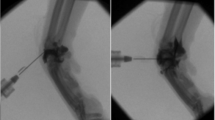Abstract
Objective
To determine normal anatomy of extrinsic and intrinsic carpal ligaments at ultrasonography (US).
Design and volunteers
In the first part of the study, two musculoskeletal radiologists retrospectively reviewed in consensus the photographs of anatomic sections and dissections derived from 20 cadaveric wrists. This cadaveric study gave the two readers the opportunity to learn the anatomy and orientation of the various extrinsic and intrinsic carpal ligaments and, thus, to develop a US protocol to facilitate the recognition of each carpal ligament. In the second part of the study, these two radiologists prospectively and independently evaluated the visibility of extrinsic and intrinsic carpal ligaments in 30 wrists of volunteers, using the same US protocol.
Results
With regard to extrinsic carpal ligaments, the radioscaphocapitate ligament (partially visible, 38%; completely visible, 62%), the radiolunotriquetral ligament (partially visible, 27%; completely visible, 73%), the palmar ulnotriquetral ligament (partially visible, 12%; completely visible, 88%), and the dorsal radiotriquetral ligament (partially visible, 7%; completely visible, 93%) were visualized at US. The dorsal ulnotriquetral ligament (partially visible, 21%; completely visible, 74%), the ulnolunate ligament (partially visible, 5%; completely visible, 70%), and the radial collateral ligament (partially visible, 18%; completely visible, 12%) were more difficult to recognize. The radioscapholunate ligament was never seen. With regard to intrinsic carpal ligaments, the dorsal (partially visible, 11%; completely visible, 89%) and palmar (partially visible, 38%; completely visible, 62%) scaphotriquetral ligaments as well as the dorsal scapholunate ligament (partially visible, 3%; completely visible, 97%) were visualized at US. The dorsal lunotriquetral ligament (partially visible, 39%; completely visible, 61%) and the palmar scapholunate ligaments (partially visible, 12%; completely visible, 81%) were more difficult to recognize.
Conclusion
US may be helpful in identifying the major extrinsic and intrinsic carpal ligaments.











Similar content being viewed by others
References
Theumann N, Favarger N, Schnyder P, Meuli R. Wrist ligament injuries: value of post-arthrography computed tomography. Skeletal Radiol 2001; 30:88–93.
Totterman SM, Miller R, Wasserman B, Blebea JS, Rubens DJ. Intrinsic and extrinsic carpal ligaments: evaluation by three-dimensional Fourier transform MR imaging. AJR Am J Roentgenol 1993; 160:117–123.
Smith DK. Volar carpal ligaments of the wrist: normal appearance on multiplanar reconstructions of three-dimensional Fourier transform MR imaging. AJR Am J Roentgenol 1993; 161:353–357.
Smith DK. Dorsal carpal ligaments of the wrist: normal appearance on multiplanar reconstructions of three-dimensional Fourier transform MR imaging. AJR Am J Roentgenol 1993; 161:119–125.
Timins ME, Jahnke JP, Krah SF, Erickson SJ, Carrera GF. MR imaging of the major carpal stabilizing ligaments: normal anatomy and clinical examples. Radiographics 1995; 15:575–587.
Brown RR, Fliszar E, Cotten A, Trudell D, Resnick D. Extrinsic and intrinsic ligaments of the wrist: normal and pathologic anatomy at MR arthrography with three-compartment enhancement. Radiographics 1998; 18:667–674.
Theumann NH, Pfirrmann CWA, Antonio GE, Chung CB, Gilula LA, Trudell DJ, Resnick D. Extrinsic carpal ligaments: normal MR arthrographic appearance in cadavers. Radiology 2003; 226:171–179.
Griffith JF, Chan DP, Ho PC, Zhao L, Hung LK, Metreweli C. Sonography of the normal scapholunate ligament and scapholunate joint space. J Clin Ultrasound 2001; 29:223–229.
Jacobson JA, Oh E, Propeck T, Jebson PJL, Jamadar DA, Hayes CW. Sonography of the scapholunate ligament in four cadaveric wrists: correlation with MR arthrography and anatomy. AJR Am J Roentgenol 2002; 179:523–527.
Finlay K, Lee R, Friedman L. Ultrasound of intrinsic wrist ligament and triangular fibrocartilage injuries. Skeletal Radiol 2004; 33:85–90.
Keogh CF, Wong AD, Wells NJ, Barbarie JE, Cooperberg PL. High-resolution sonography of the triangular fibrocartilage: initial experience and correlation with MRI and arthroscopic findings. AJR Am J Roentgenol 2004; 182:333–336.
Landis JR, Koch GG. The measurement of observer agreement for categorical data. Biometrics 1977; 33:159–174.
Sennwald GR, et al. The anatomy of the palmar scaphotriquetral ligament. J Bone Joint Surg Br 1994; 76:147–149.
Yin Y, Evanoff B, Gilula LA, Pilgram TK. Evaluation of selective wrist arthrography of contralateral asymptomatic wrists for symmetric ligamentous defects. AJR Am J Roentgenol 1996; 166:1067–1073.
Wright TW, Del Charco M, Wheeler D. Incidence of ligament lesions and associated degenerative changes in the elderly wrist. J Hand Surg [Am] 1994; 19:313–318.
Berger RA. The gross and histologic anatomy of the scapholunate interosseous ligament. J Hand Surg [Am] 1996; 21: 170–178.
Li G, Rowen B, Tokunaga D, Ryu J, Kato H, Kihira M. Carpal kinematics of lunotriquetral dissociations. Biomed Sci Instrum 1991; 27:273–281.
Linscheid RL, Dobyns JH. Dynamic carpal instability. Keio J Med 2002; 51:140–147.
Berger RA, Kauer JM, Landsmeer JM. Radioscapholunate ligament: a gross anatomic and histologic study of fetal and adult wrists. J Hand Surg [Am] 1991; 16:350–355.
Sonography of the elbow, wrist, and hand. van Holsbeeck M, Introcaso JH. Musculoskeletal Ultrasound, 2nd edn. Mosby, 2001. 517–571.
Acknowledgements
We thank Chadi Khalil, MD, for his assistance in reviewing the manuscript.
Author information
Authors and Affiliations
Corresponding author
Rights and permissions
About this article
Cite this article
Boutry, N., Lapegue, F., Masi, L. et al. Ultrasonographic evaluation of normal extrinsic and intrinsic carpal ligaments: preliminary experience. Skeletal Radiol 34, 513–521 (2005). https://doi.org/10.1007/s00256-005-0929-4
Received:
Revised:
Accepted:
Published:
Issue Date:
DOI: https://doi.org/10.1007/s00256-005-0929-4




